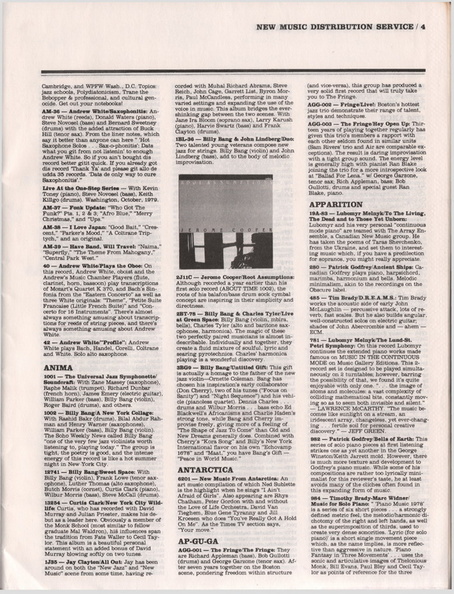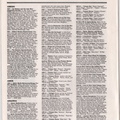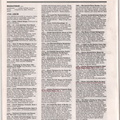6846/18858

Cambridge, and WPFW Wash., D.C. Topics: jazz schools, Polydiatonicism, Trane the Bebopper & professional, and cultural genocide. Get out your notebooks!
AM-36 — Andrew White/Saxophonitis: Andrew White (reeds), Donald Waters (piano), Steve Novosel (bass) and Bernard Sweetney (drums) with the added attraction of Buck Hill (tenor sax). From the liner notes, which say it better than anyone can here “ ‘Hot Saxophone Solos . . . Sax-o-phonitis’: Dats what you git from not listenin’ to enough Andrew White. So if you ain’t bought dis record better gitit quick. If you already got dis record Thank Ya’ and please git alio de udda 35 records. ‘Dats de only way to cure Saxophonitis’.”
Live At the One-Step Series — With Kevin Toney (piano), Steve Novosel (bass), Keith Killgo (drums). Washington, October, 1979.
AM-37 — Fonk Update: “Who Got The Funk?” Pts. 1, 2 & 3; “Afro Blue,” “Merry Christmas,” and “Ups.”
AM-38 — I Love Japan: “Good Bait,” “Crescent,” “Parker’s Mood,” “A Coltrane Triptych,” and an original.
AM-39 — Have Band, Will Travel: “Naima,” “Superfly,” “The Theme From Mahogany,” “Central Park West.”
40 — Andrew White/Plays the Oboe: On this record, Andrew White, oboist and the Andrew’s Music Chamber Players (flute, clarinet, horn, bassoon) play transcriptions of Mozart’s Quartet K 370, and Bach’s Sin-fonia from the “Eastern Concerto” as well as three White originals: “Theme”, “Petite Suite Francaise (Little French Suite)” and “Concerto for 16 Instruments”. There’s almost always something amusing about transcriptions for reeds of string pieces, and there’s always something amusing about Andrew White.
42 — Andrew White/”Proflle”: Andrew White plays Bach, Handel, Corelli, Coltrane and White. Solo alto saxophone.
ANIMA
1001 — The Universal Jazz Symphonette/ Soundcraft: With Zane Massey (saxophone), Raphe Malik (trumpet), Richard Dunbar (french horn), James Emery (electric guitar), William Parker (bass), Billy Bang (violin), Roger Baird (drums), and others.
1002 — Billy Bang/A New York Collage: With Rashid Bakr (drums), Bilal Abdur Rahman and Henry Warner (saxophones), William Parker (bass), Billy Bang (violin). The Soho Weekly News called Billy Bang “one of the very few jazz violinists worth listening to, playing today.” The group is tight, the poetry is good, and the intense energy of this record is like a hot summer night in New York City.
12741 — Billy Bang/Sweet Space: With Billy Bang (violin), Frank Lowe (tenor saxophone), Luther Thomas (alto saxophone), Butch Morris (comet), Curtis Clark (piano), Wilbur Morris (bass), Steve McCall (drums).
13254 — Curtis Clark/New York City Wildlife: Curtis, who has recorded with David Murray and Julian Priester, makes his debut as a leader here. Obviously a member of the Monk School (most similar to fellow graduate Mai Waldron), his influences span the tradition from Fats Waller to Cecil Taylor. This album is a beautiful personal statement with an added bonus of David Murray blowing softly on two tunes.
1J35 — Jay Clayton/All Out: Jay has been around on both the “New Jazz” and “New Music” scene from some time, having recorded with Muhal Richard Abrams, Steve Reich, John Cage, Garrett List, Byron Morris, Paul McCandless, performing in many varied settings and expanding the use of the voice in music. This album bridges the ever-shinking gap between the two scenes. With Jane Ira Bloom (soprano sax), Larry Karush (piano), Harvie Swartz (bass) and Frank Clayton (drums).
1BL-36 — Billy Bang & John Lindberg/Duo: Two talented young veterans compose new jazz for strings. Billy Bang (violin) and John Lindberg (bass), add to the body of melodic improvisation.
2J11C — Jerome Cooper/Root Assumptions: Although recorded a year earlier than his first solo record (ABOUT TIME 1002), the roots of his balafon/bass drum sock cymbal concept are inspiring in their simplicity and directness.
2BT-78 — Billy Bang & Charles Tyler/Live at Green Space: Billy Bang (violin, mbira, bells), Charles Tyler (alto and baritone saxophones, harmonica). The magic of these two perfectly paired musicians is almost indescribable. Individually and together, they create a fluid mixture of soulful, lyric and searing pyrotechnics. Charles’ harmonica playing is a wonderful discovery.
3BG9 — Billy Bang/Untitled Gift: This gift is actually a homage to the father of the new jazz violin—Ornette Coleman. Bang has chosen his inspiration’s early collaborator (Don Cherry), two of his tunes (“Focus on Sanity”) and “Night Sequence”) and his vehicle (pianoless quartet). Dennis Charles . . . drums and Wilbur Morris . . . bass echo Ed Blackwell’s Africanisms and Charlie Haden’s strong tone, while Bang and Cherry improvise freely, giving more of a feeling of “The Shape of Jazz To Come” than Old and New Dreams generally does. Combined with Cherry’s “Kora Song” and Billy’s New York International flavor on his own “Echovamp 1678” and “Maat,” you have Bang’s Gift — “Peace in World Music.”
ANTARCTICA
6201 — New Music From Antarctica: An art music compilation of which Ned Sublette is the highlight when he sings “I Ain’t Afraid of Girls”. Also appearing are Rhys Chatham, Peter Gordon with and without the Love of Life Orchestra, David Van Tieghem, Blue Gene Tyranny and Jill Kroesen who does “You’ve Really Got A Hold On Me”. As the Times TV section says, “Your move.”
AP-GU-GA
AGG-001 — The Fringe/The Fringe: They are Richard Appleman (bass), Bob Gullotti (drums) and George Garzone (tenor sax). After seven years together on the Boston scene, pondering freedom within structure
(and vice-versa), this group has produced a very solid first record that will truly take you to The Fringe.
AGG-002 — Fringe/Live!: Boston’s hottest jazz trio demonstrate their range of talent, styles and techniques.
AGG-003 — The Fringe/Hey Open Up: Thirteen years of playing together regularly has given this trio’s members a rapport with each other seldom found in similar units (Sam Rivers’ trio and Air are comparable exceptions). The result is daring improvisation with a tight group sound. The energy level is generally high with pianist Ran Blake joining the trio for a more introspective look at “Ballad For Lena.” w/ George Garzone, tenor sax; Rich Appleman, bass; Bob Gullotti, drums and special guest Ran Blake, piano.
APPARITION
19A-83 — Lubomyr Meinyk/To The Living, The Dead and to Those Yet Unborn: Lubomyr and his very personal “continuous mode piano” are teamed with The Array Ensemble, a Canadian New Music group. He has taken the poems of Taras Shevchenko, from the Ukraine, and set them to interesting music which, if you have a predilection for sopranos, you might really appreciate.
280 — Patrick Godfrey/Ancient Ships: Canadian Godfrey plays piano, harpsichord, marimba, harmonium and bells. Melodic minimalism, akin to the recordings on the Obscure label.
485 — Tim Brady/D.R.E.A.M.S.: Tim Brady works the acoustic side of early John McLaughlin — percussive attack, lots of reverb, fast scales. But he also builds angular, well-constructed solos on electric guitar; shades of John Abercrombie and — ahem — ECM.
781 — Lubomyr Melnyk/The Lund-St. Petri Symphony: On this record Lubomyr continues the extended piano works made famous on MUSIC IN THE CONTINUOUS MODE on Music Gallery Editions. This 2-record set is designed to be played simultaneously on 2 turntables; however, barring the possibility of that, we found it’s quite enjoyable with only one. “. . . the image of atoms and molecules: a vast complexity of colliding mathematical bits, constantly moving so as to seem both invisible and silent.” — LAWRENCE McCARTHY. “The music becomes like sunlight on a stream, an iridescent array, changeless, yet ever-changing . . . fertile soil for personal creative discovery.” — JEFF GREEN.
982 — Patrick Godfrey/Bells of Earth: This series of solo piano pieces at first listening strikes one as yet another in the George Winston/Keith Jarrett mold. However, there is much more texture and development to Godfrey’s piano music. While some of his compositions are rather too lyrically minimalist for this reviewer’s taste, he at least avoids many of the cliches often found in this expanding form of music.
984 — Timothy Brady-Marc Widner/Music for Solo Piano: “ ‘Piano Music 1978’ is a series of six short pieces ... a strongly defined metric feel, the melodic/harmonic dichotomy of the right and left hands, as well as the superimposition of thirds, used to create very dense sonorities. ‘Lyric (for solo piano)’ is a short single movement piece which, as the name implies, is more reflective than aggressive in nature. ‘Piano Fantasy in Three Movements’ . . . uses the sonic and articulative images of Thelonious Monk, Bill Evans, Paul Bley and Cecil Taylor as points of reference for the three


0 comments